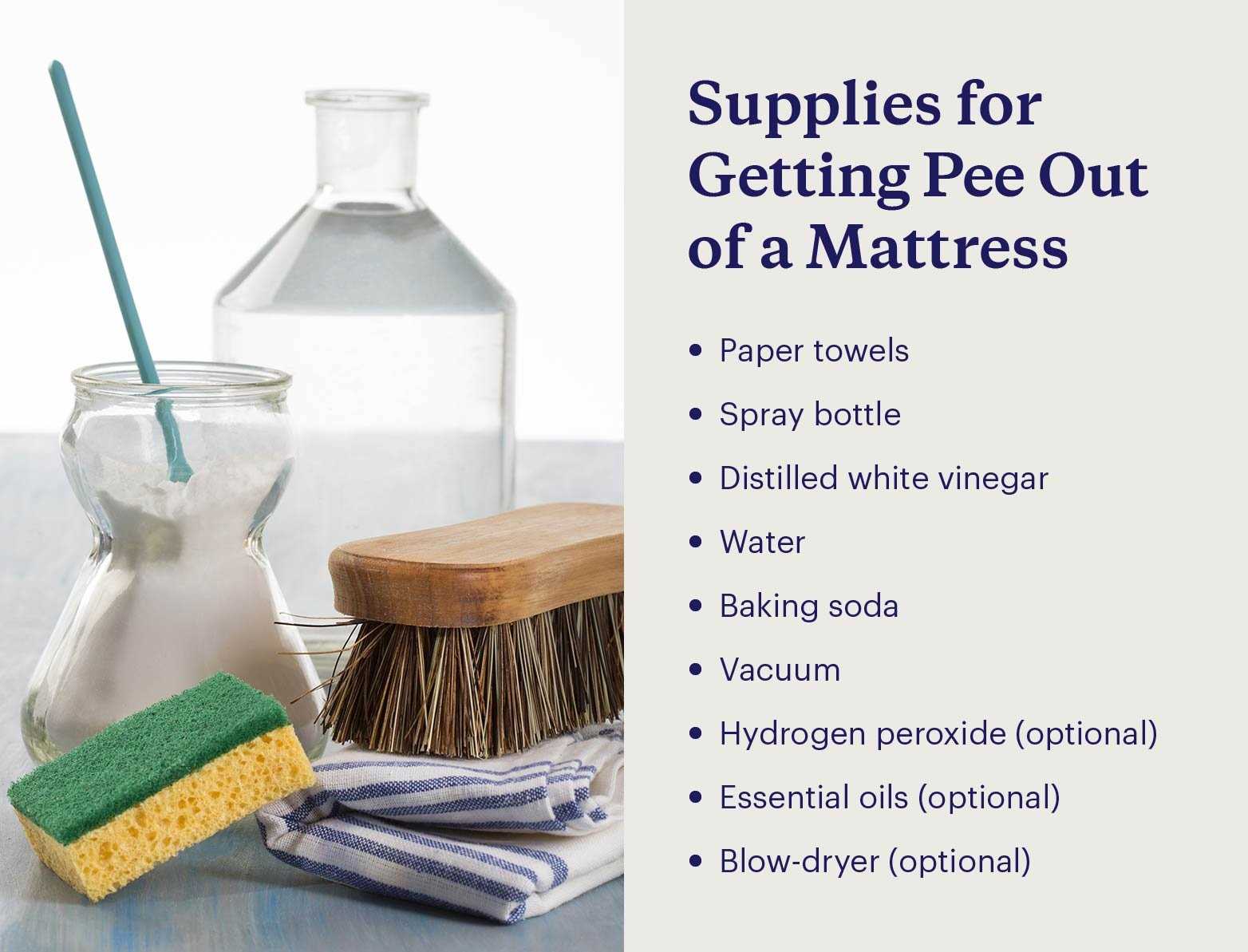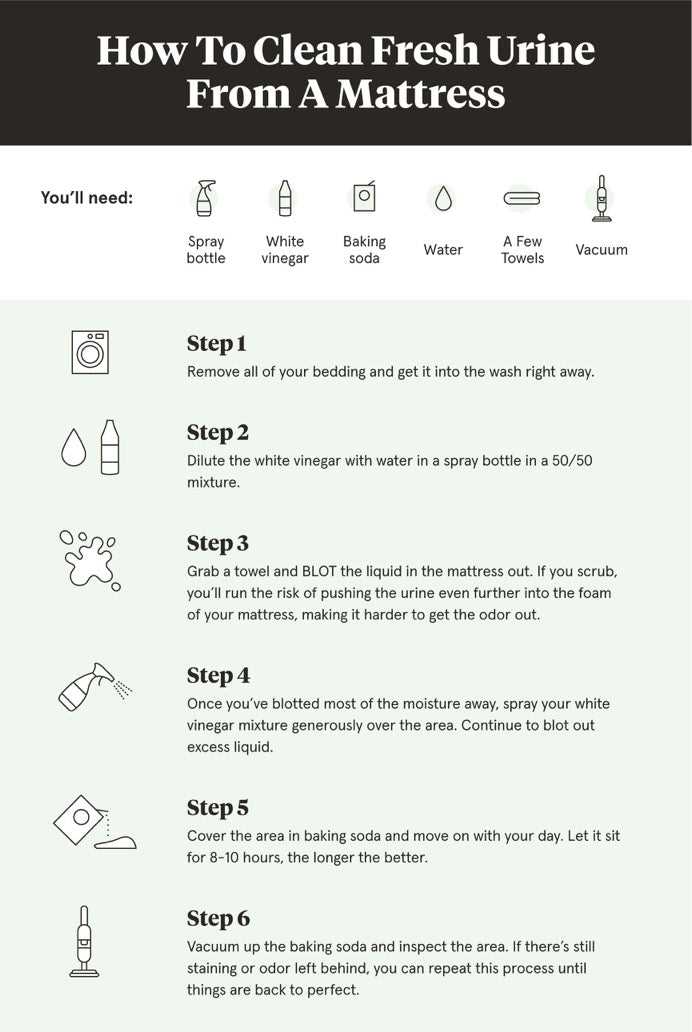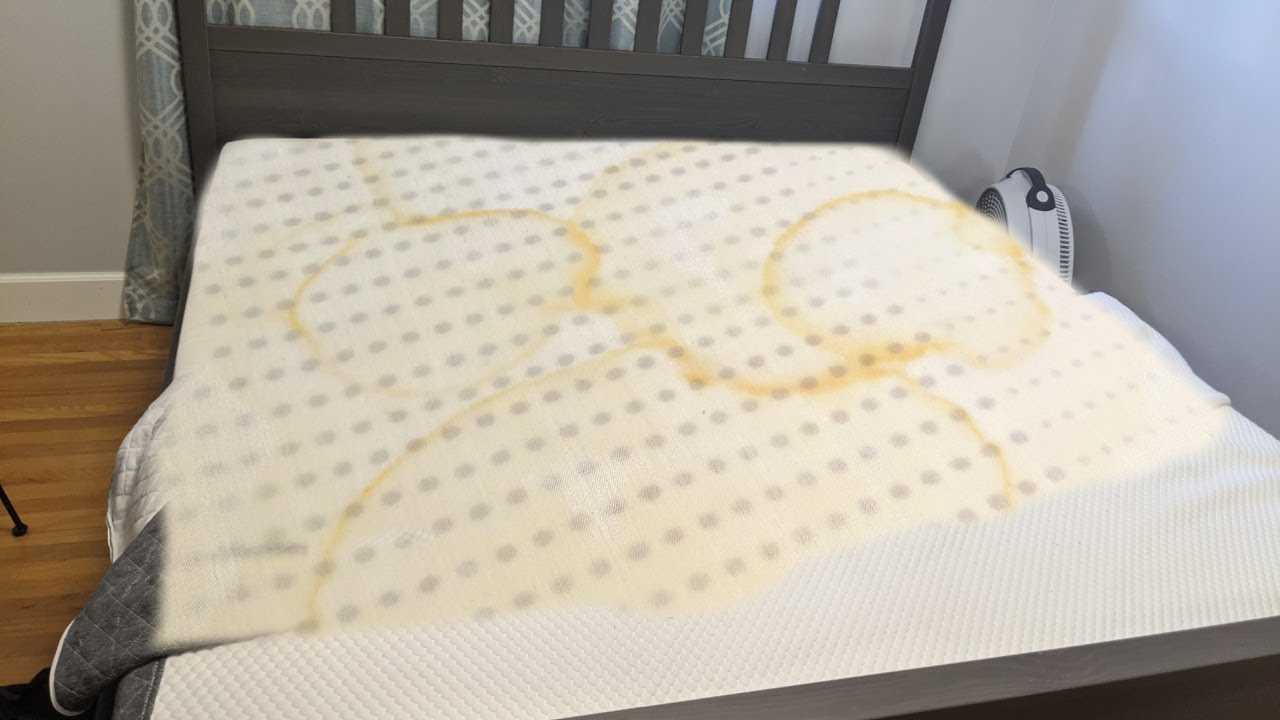



Act quickly with an absorbent cloth to blot the stain. Press firmly to soak up as much liquid as possible without rubbing, which can spread the problem further.
Mix equal parts of white vinegar and water in a spray bottle. Lightly mist the affected area, allowing the solution to penetrate the stain. After a few minutes, blot again with a clean cloth to lift the moisture.
Sprinkle baking soda generously over the damp spot. This will help neutralize any lingering odors. Let it sit for several hours, or overnight if possible, before vacuuming it up.
For persistent odors, consider using an enzymatic cleaner designed specifically for organic stains. Follow the instructions carefully, ensuring thorough coverage of the affected region.
Identify the Stain and Odor Source
First, locate the affected area by checking for yellowish stains. This discoloration indicates where the issue lies. If the mattress is dark, use a UV flashlight to spot the urine stains more easily, as they will glow under UV light.
Next, assess the smell. A strong, pungent odor typically suggests a fresh incident, while a milder scent may indicate older stains. Sniff around the mattress, focusing on seams and crevices, as those are common spots for liquid to seep in.
Use your hands to gently press the fabric in the stained areas. If it feels damp or has a distinct odor, mark this location for treatment. Accurate identification of both the stain and the source of the smell is crucial for effective remediation.
Gather Necessary Cleaning Supplies
First thing’s first, I recommend collecting these items: an enzymatic cleaner specifically designed for removing organic stains and odors, white vinegar, baking soda, and clean cloths or paper towels. Make sure to have a spray bottle handy for the vinegar solution and a vacuum cleaner for any leftover residue.
Enzymatic cleaners break down those stubborn compounds, while vinegar and baking soda help neutralize odors effectively. Cloths are essential for blotting, and using a vacuum will ensure all particles are removed after treatment.
For a quick reference, if you need information on other cleaning supplies or products, check out this link: are lawn mower batteries lithium.
Having all these supplies at hand will make the entire process smoother and more successful. Trust me, it’s all about being prepared!
Blot the Area to Absorb Excess Moisture

Immediately grab a clean, dry cloth or paper towel. Press it firmly onto the affected spot to soak up as much liquid as possible. Avoid rubbing, as this can push the stain deeper into the fibers.
Steps to Follow:
- Apply gentle pressure to the stained area.
- Change the cloth or towel frequently until no more moisture is absorbed.
- Ensure the area is not dripping wet before proceeding to the next cleaning step.
Once the excess liquid is soaked up, the cleaning process can continue effectively. This initial step is crucial for successful odor removal and stain treatment.
Apply a cleaning solution for pet stains
For the best results, a mixture of equal parts white vinegar and water works wonders on those troublesome spots. This solution neutralizes odors effectively. Spray the affected area generously without soaking the fabric.
After applying the mixture, let it sit for about 10-15 minutes. This allows the solution to penetrate the fibers and break down the stain.
Next, dab the area gently with a clean cloth or paper towel to lift the stain. Avoid rubbing, as this might spread the mess further.
To enhance the cleaning process, consider adding a small amount of dish soap to the vinegar-water mix. This can help break down the residues more effectively.
For those particularly stubborn stains, enzyme-based cleaners can be a great choice. They target the organic compounds in the mess, ensuring a thorough removal.
Always test any solution on a hidden area of the mattress first to ensure it doesn’t cause discoloration or damage.
Once the stain is treated, allow the area to dry completely. This helps prevent any lingering odor and keeps the mattress fresh.
| Cleaning Solution | How to Use |
|---|---|
| Vinegar and Water | Mix equal parts, spray, let sit, then blot. |
| Dish Soap Addition | Add a few drops to the vinegar mix for extra cleaning power. |
| Enzyme Cleaner | Apply according to the manufacturer’s instructions for best results. |
Rinse and Dry the Mattress Properly
After applying a suitable cleaning solution, it’s crucial to rinse the surface thoroughly. Use a clean cloth dampened with water to wipe the area, ensuring that all cleaning agents are removed. This step helps prevent any residue that could attract more dirt or odors.
Once rinsed, focus on drying the mattress effectively. Use clean towels to blot the area, absorbing as much moisture as possible. For optimal results, I recommend placing the mattress in a well-ventilated area or using a fan to speed up the drying process. Avoid using heat sources directly on the fabric, as this can damage the materials.
Final Checks

After the mattress has dried completely, perform a quick smell test to ensure no lingering scents remain. If any odor persists, consider applying a pet odor neutralizer or baking soda to the area and letting it sit before vacuuming it off.
For those dealing with stress-related issues, consider exploring the best cbd for cats stress options available. Keeping a stress-free environment can help prevent future accidents.
Prevent Future Incidents with Training Tips

Establish a designated litter area. Encouragement and consistency are key. Always guide to the box after meals and naps.
Positive reinforcement builds good habits. Treats and praise work wonders when using the litter box correctly.
Observe behaviors closely. Recognize signs of discomfort or the need to relieve oneself. Quick responses can prevent accidents.
Limit access to areas where mishaps have occurred. Blocking off spaces can reduce the likelihood of repeating past mistakes.
Consider stress factors. Changes in environment or routine may prompt anxiety. Creating a calm space can help alleviate this.
Regular vet check-ups ensure health issues aren’t a factor. Addressing potential medical concerns promptly is essential.
Engagement in playful activities reduces boredom. Keeping entertained minimizes unwanted behaviors linked to frustration.
Monitor box cleanliness. A dirty litter box can discourage use. Regularly cleaning encourages a positive experience.
FAQ:
What are the first steps to take when cleaning cat pee off a mattress?
Begin by blotting the area with paper towels or a clean cloth to absorb as much liquid as possible. Press down firmly to soak up the urine, but avoid rubbing, as this can spread the stain. After blotting, rinse the area with cold water and blot again to remove excess moisture.
What cleaning solutions can I use to remove the odor of cat urine from my mattress?
There are several options for cleaning solutions. A popular choice is a mixture of equal parts white vinegar and water. Spray the solution onto the stained area and let it sit for about 10-15 minutes before blotting it up. Another option is to use an enzyme cleaner specifically designed for pet stains, which breaks down the proteins in the urine, effectively eliminating odors.
How can I ensure that all traces of cat pee are removed from my mattress?
After treating the stain with vinegar or an enzyme cleaner, sprinkle baking soda over the area to absorb any remaining odors. Leave the baking soda on for several hours, or overnight if possible, then vacuum it up. For extra precaution, consider using a blacklight to check for any lingering stains, as they will glow under UV light. Repeat the cleaning process if necessary.
Is it safe to use bleach or harsh chemicals on my mattress to clean cat urine?
It is not recommended to use bleach or harsh chemicals on your mattress, as they can damage the fabric and may not effectively remove the odor. Instead, opt for natural solutions like vinegar and baking soda or commercial enzyme cleaners that are safe for use on upholstery. Always check the mattress care label for specific cleaning instructions and test any solution on a small, inconspicuous area first.








